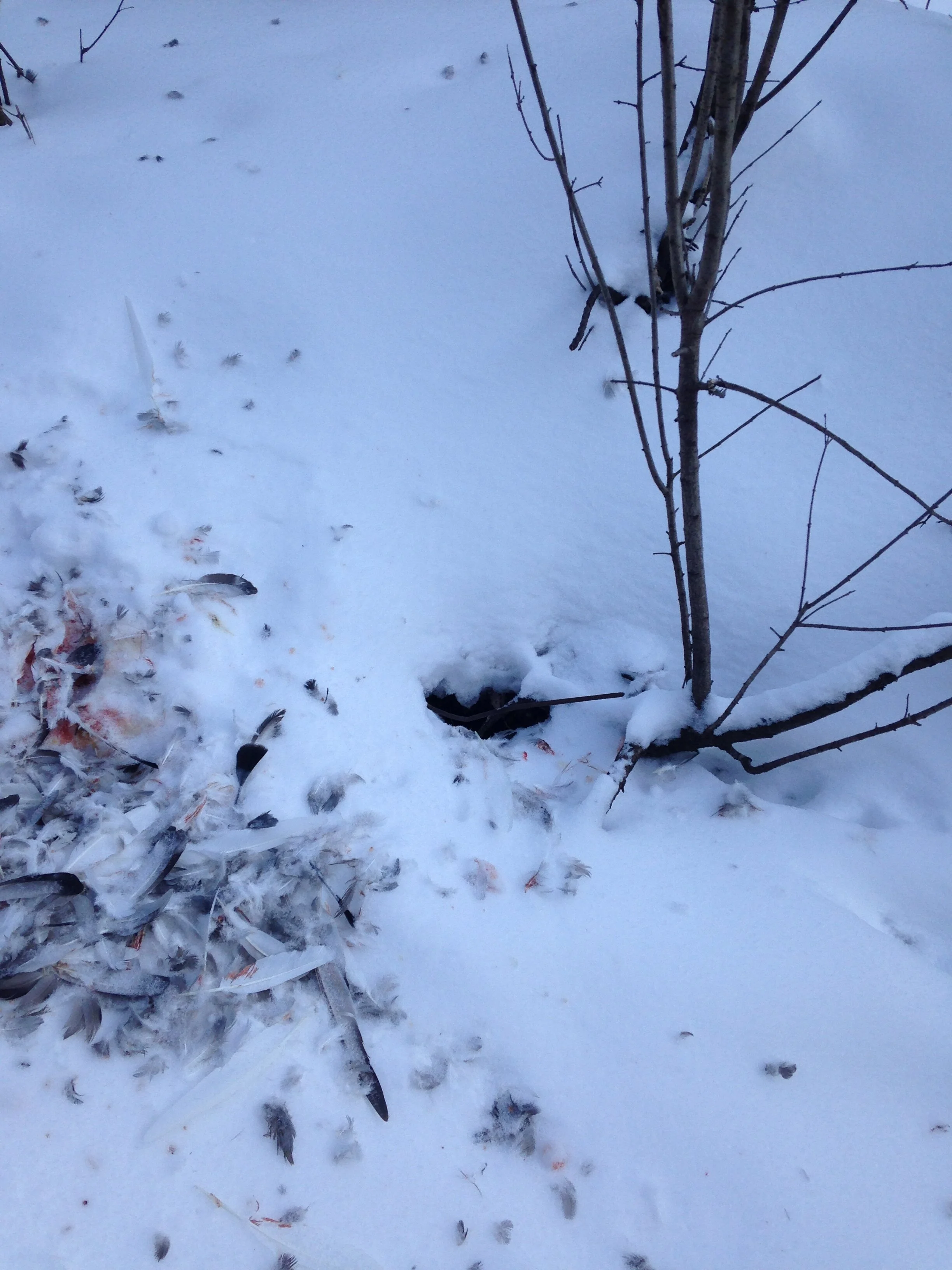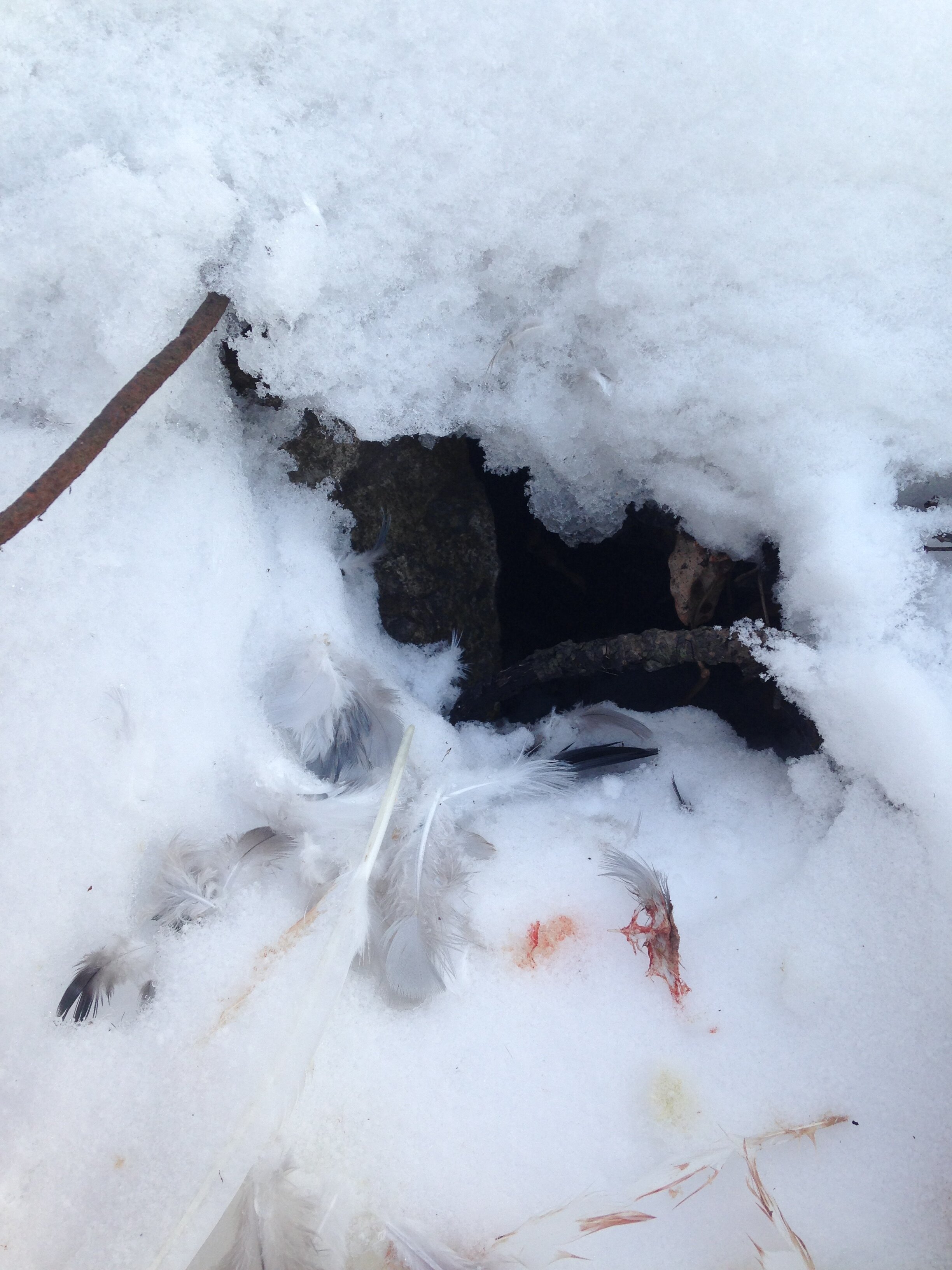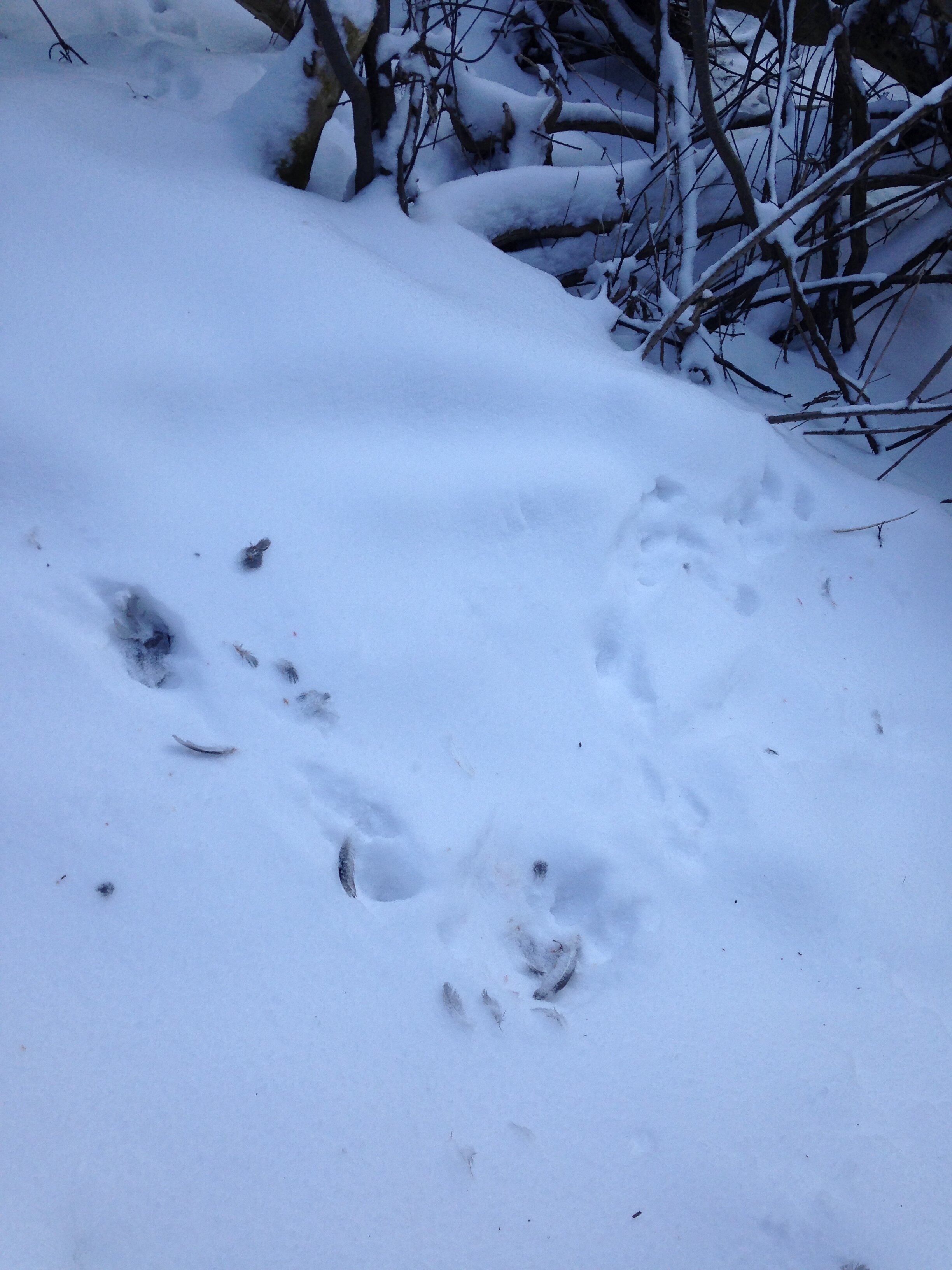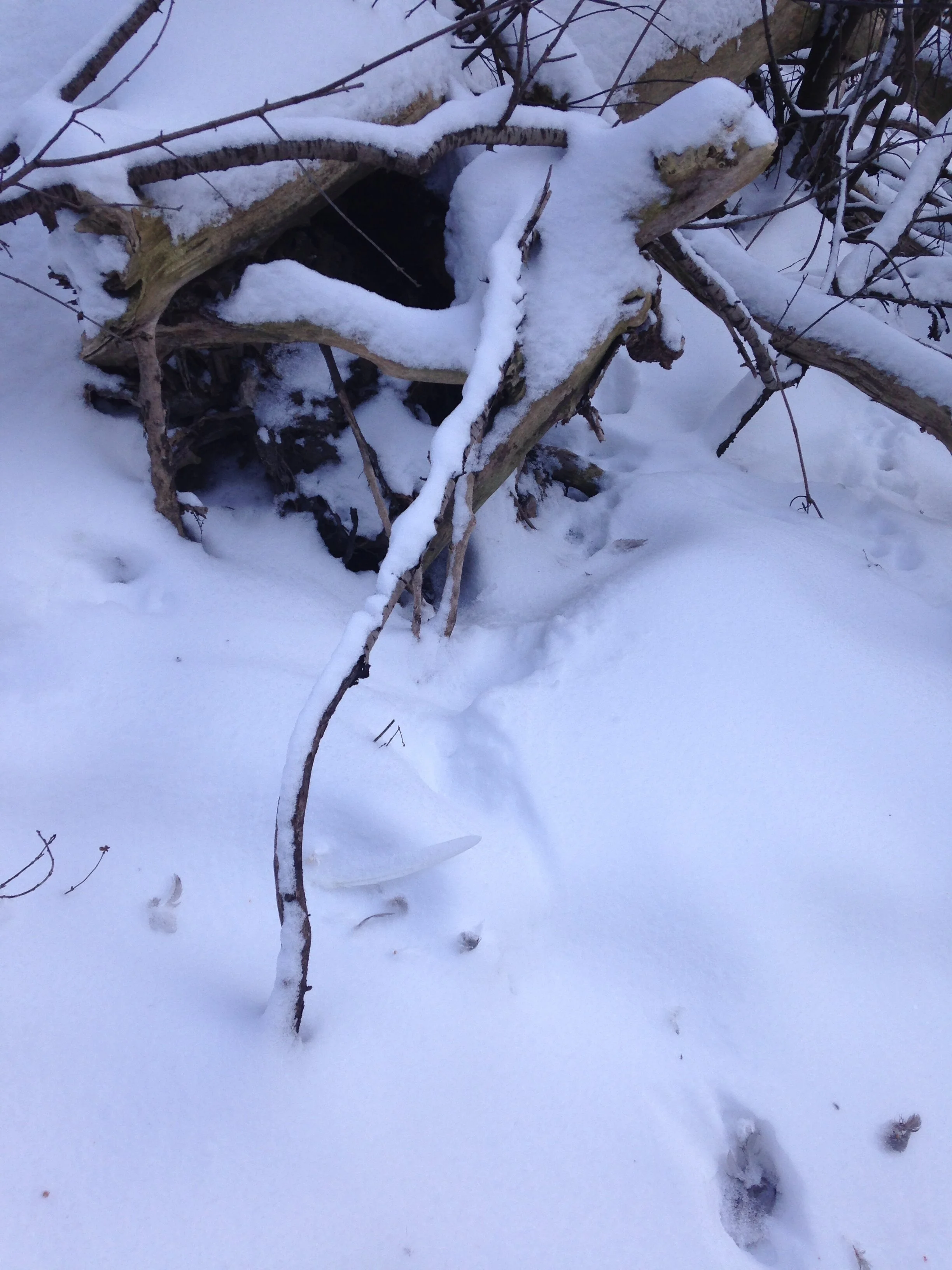Rock Dove Kill site?
The temperature was about -7°C and the wind was about 11kmphr coming from the Northwest. It clear and nearly cloudless and the sun was up but not yet cresting the valley walls from my vantage point down by the river.
I was on my morning walk, trying to ignore the Eastern Cottontail Rabbit (Sylvilagus floridanus) tracks weaving through the tall dead stalks from last year, but instead just trying to briskly make my way along the narrow path beside the water. I had to duck a couple of fallen Manitoba Maples (Acer negundo) and crescent a few Buckthorns (Rhamnus cathartica) and Red-Osier Dogwoods (Cornus sericea) but as I continued walking up the path I came across a large pile of feathers.
Almost immediately I recognized the feathers as belonging to a Rock Dove (Columba livia). In my area, the Rock Dove falls in with Eastern Cottontails, Meadow Voles (Microtus pennsylvanicus) as common prey species. Everyone seems to eat at least one of these animals, and they get got often. Once I realized that it was the Rock Dove, I quickly got to wondering about who it was that had got them, and had they found the Pigeon (other name for Rock Dove) already dead, or did they hunt and kill the animal? I have found a dead Dove stuck in the middle of the frozen iced over river before, only later to return and see Coyote (Canis latrans) tracks leading to and away from the now hollowed form of where the Dove had been. Was this the same scenario?
I looked carefully for tracks, trying to skirt the whole scene, not stepping anywhere that been impacted the kill. I was even doing a good job at not knocking any debris from the shrubs and trees around me down into the snow muddling up the site, for a while.
I noticed a hole in the snow (around the middle left side of the image above) which appeared to have tracks around the mouth of. I also noticed some tracks leading up from the river, which reminded me that I had been seeing a couple potential predators tracks around this part of the river lately : Raccoon (Procyon lotor) and Mink (Neovison vison). I considered these two potential predators. Racoon totally was possible, but it has been fairly cold for the past couple of days (until yesterday) and I know that Raccoons will tend to hole up for a while on the coldest days. They don’t hibernate, but they take shelter and sleep off the worst of the cold until a warm spell when they will emerge and look for food. The day before had brought 5 - 6 cm ( ~2 in) of snow and had an average temperature of about -3° C, which was not too cold. Did a Raccoon wake up, get to moving and find an accessible and easily taken Rock Dove?
The other possible predator was a Mink. I had seen Mink tracks along the rivers edge quite a bit in the past few days, and had had friends tell me they’d seen the Mink as well in the mornings when they were out walking their Dog (Canis lupus familiaris). The trail coming up from the river would also implicate the Mink, as they tend to make their way along the frozen rivers edge, coming up on the bank to explore nooks and cover. I also know that Minks would be active despite the cold and would also be inclined to take a Rock Dove, though I am not sure if I had seen signs of that before.




The tracks leading up to the hole interested me, as well as the hole itself. I have not known Raccoons to be able to squeeze into such a small hole as this one, which measured 88 mm (3.5 in) D, but at the same time, I couldn’t be certain, from what I saw at the hole, that the animal had actually gone down into it, perhaps only explored the hole, sniffing at it, and listening perhaps. There was also no definitive sign that an animal actually used the hole so really it might not have a bearing on who the predator might have been. But there were littered feathers about the hole, a couple bloody ones and tracks in a sort of 2x2 pattern close by.
Raccoons baseline gait is a 2x2 walking gait, where the hind from one side will land opposite the front from the other side as they walk. A Mink on the other hand, will often have a 2x2 loping gait, where in their stride they throw their front feet forward, and then push off with those front feet, and just as they do, their hind feet land just on top of the tracks those front feet just left behind, often making it look like there are just two feet landing per group. Here are some photos which might help, with the Raccoon on the left, and Mink on the right:
Raccoon 2x2 walk
Mink 2x2 lope
Here is a slowed down video of the 2x2 lope from the intro to the PBS Nature documentary "Weasels: Fiesty and Fearless"
Now there are some differences between Raccoon and Mink tracks that help to differentiate them. The Raccoons hands give them away. They have longer narrower hind feet, but smaller wider fronts. When you see them side by side you can make out who it was fairly easily.
The Minks feet are pretty similar to one another, but the front tracks can be a little bit longer. These front tracks are the ones mostly concealed in the 2x2 lope as they are covered by the imprint of the hind feet landing on top. Also, the trail width of the two animals is slightly different, with the Raccoon being the wider of the two (with only very litter overlap between them).
The trail width for the 2x2 tracks around the feathers was about 9 cm (3.54 in), and pictured above was about 11 cm (4.33 in).
Some notes on the interesting things I took away from this spot. First was the corn pieces around the feathers, likely from the Rock Doves stomach, but this then begs the question, where are they going for food? We don’t have any corn fields anywhere near by, and most of it would be deep under snow. Do Pigeons scratch away the snow to access the grains and seeds below, similar to Turkeys? If not, is there someone local who is feeding them? I’m going to have to watch the Pigeons more carefully from now on. Secondly, some of the larger feathers which had blood on them near the lower ends of the shaft just above what is called the “Superior umbilicus”.
Is this where the maybe Mink put their mouth on the feather so as to pull it out? Or do Mink put their feet on the feather to hold it in place, and then use their mouths to pull the body away from the feather? I’ll have to keep track now of the Mink/Bird kill sites I find and see if this pattern of blood smear happens often enough to i.d. a Mink.
Lastly a neat discovery was a feather that was just growing. I assumed that that was what I had found amidst the mess of feathers, but I wasn’t sure until I got home. I had put the feather into my Question book and stored it there so as not to bend it or wreck the plumage, but when I got home I realized my book had compressed the calamus/quill, and there was blood on the pages of my book where the blood had been squished out the bottom.
I love how a simple walk in the morning, just to get out of the house can turn into a chance to really look at the details of a killsite and study the gaits of the possible predators, and look at the structure of a feather. What amazing teachers these wild neighbours are. I am grateful.







